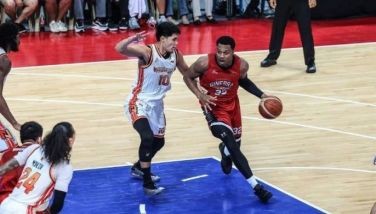Equal incentives for differently-abled athletes
Friday the 13th was a lucky day for the athletes who represented the Philippines in the ASEAN Paragames held in Solo, Indonesia after the last Southeast Asian Games in Palembang and Jakarta. They received from the Philippine Sports Commission incentives worth P1.65 million. Our differently-abled athletes received cash rewards for medals won in swimming, athletics, table tennis, chess, archery and bowling. It was an impressive medal haul despite having a small delegation entered in only six of 11 sports contested.
However, the occasion also underscored the existing disparity between what the differently-abled athletes receive vis-a-vis those who go to competitions for abled athletes like the Southeast Asian Games. Differently-abled athletes receive one-fourth of the incentives that athletes without disabilities receive. This is a long-standing situation the Philippine Sports Association for the Differently-Abled (Philspada) has been trying to address. There seems to be no concrete explanation for this circumstance to prevail.
“There is a pending bill in Congress to amend RA 9064 otherwise known as “National Athletes, Coaches and Trainers Benefits and Incentives Act of 2001, and for Other Purposes.” If passed, it will recognize national athletes with disabilities so that they can enjoy and receive cash incentives and benefits equal to the abled body athletes,” explains former PSC commissioner Mike Barredo, president of Philspada. “We are hoping that after three Congresses it will finally pass with some ‘push’ from others sympathetic to the cause.”
The PSC-Philspada National Paralympic Committee (NPC) which Barredo chairs will hold the National Para Games at the Marikina Sports Complex from Feb. 1-7, and Barredo is hoping against hope that there will be some development by then.
Section 2 or the Statement of Policy of RA 9064 (enacted April 5, 2001) states that “The State shall promote excellence in sports and through sports by providing for the welfare of national athletes, coaches and trainers competing for the country and particular benefits and incentives for those who have brought honor and recognition to the country by winning in international competitions.” Technically, it does not differentiate in terms of abled and differently-abled athletes, so there should actually be no distinction between the two in practice. The spirit of the law was to care for and give benefits to national athletes, with no bias against any of them for any reason.
Section 3, the definition of terms, further states that “National Athletes – shall refer to athletes who are Filipino citizens, members of the national training pool, recognized and accredited by the Philippine Olympic Committee (POC) and the Philippine Sports Commission (PSC) and who have represented the country in international competitions.” It does not specify whether they are abled or not, either, nor does it define the national training pool as meaning only able-bodied athletes.
Philspada athletes are continually representing the country in international competitions. They see action – and medal – in the ASEAN Para Games, Asian Para Games, and will compete in the Paralympic Games after the London Olympics. They face the same challenges as regular national athletes, in that they have to train and qualify for their events, as well. They are not given any special treatment for their events, save perhaps for the convenience of necessary specialized equipment and ramps for wheelchair-bound athletes in certain venues.
The great avatar of the differently-abled athlete was two-time Olympic gold medal winner Abebe Bikila of Ethiopia. After becoming the first Ethiopian to win an Olympic gold medal in the 1960 marathon (which he ran barefoot), Bikila won the event again (this time with shoes) in 1964. He was forced to retire midway through the 1968 event due to injury. After a car accident during a protest rally in 1969, Bikila was paralyzed from the waist down. He became a proficient archer, and in 1970 won a 25-kilometer cross-country sledge competition in Norway. He died in October of 1973.
Section 11 of RA 9064 further states that “The PSC is hereby authorized to adjust the schedule of incentives in Section 8 hereof, based on studies, consultations and public hearings with relevant agencies to reflect the economic needs of the athletes. No memorandum, order, or issuance shall diminish the prescribed schedule of incentives...”
Therefore, even without an amendment to the law, the PSC is authorized to conduct hearings and do research on what is fair and equitable to differently-abled athletes. The agency merely has to consult certain experts and perhaps even the athletes themselves. In the past, the PSC has independently increased the allowances of national athletes to reflect the needs of the times. It can do so again now, perhaps in cooperation with our elected legislators.
Admittedly, being around then differently-abled makes some people uncomfortable, talking about it even more so. But is there really any reason to set apart athletes with disabilities? Don’t they work just as hard to develop themselves beyond what other people are able to do?
There is only one real question about the entire situation to sum up the challenge confronting our differently-abled athletes. It is the question they first overcame to excel in their respective fields, and is now the question we ask our sports authorities.
That question is: Why not?
- Latest
- Trending






























